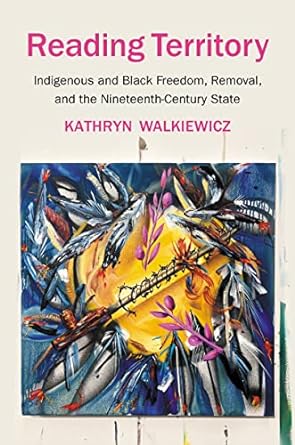The Book
Reading Territory: Indigenous and Black Freedom, Removal, and the Nineteenth-Century State
The Author(s)
Kathryn Walkiewicz

Scholarship that explores intersectional histories and identities has ballooned in recent years, and it adds an important corrective to the one- and two-dimensional history that has so long dominated academia. Narrating this complicated history poses challenges for any writer, and Kathryn Walkiewicz develops a unique and effective heuristic tool for exploring white colonial violence against Indigenous and Black ways of being in Reading Territory. Walkiewicz challenges “the settler definition of territory as a singular sovereign’s land (or water) base.” Rather, “territory encourages movement and adaptability” in order to “imagine spatial possibilities that emerge beyond the colonial, propertied definition of the term.”[1] Walkiewicz views white settler colonialism through the prism of state-making – how print culture, maps, and government policies brought states, and thus the white, patriarchal nation, into being. They also explore how “sovereign printscapes,” like Indigenous and Black newspapers and literature, challenged white settler logic and revealed the messiness of history. Examining moments in nineteenth-century history when Indigeneity and Blackness got entangled in ways that questioned the inevitability of U.S. expansion via state-making, like the Seminole Wars, Bleeding Kansas, and the creation of so-called Oklahoma, Walkiewicz asks us to “think collectively about speculative futures beyond the state.”[2] The book breathes life into a territorial history that clearly demonstrates how Black and Indigenous oppression and freedom are inseparable.
An assistant professor in the Department of Literature at UC-San Diego and citizen of the Cherokee Nation, Walkiewicz draws upon a wide variety of archival sources to explain how documents as varied as land surveys, maps, political cartoons, and pamphlets all contributed to the Removal process, a word which they capitalize on purpose “to signal the ways it has operated as a violence across space and time.”[3] Walkiewicz’s measured attention to both Black and Native subjects consistently reinforces how white settler colonialism depended on Indigenous dispossession and Black enslavement for its (impartial) success. They demonstrate how Georgia asserted its “state’s rights” to Indigenous land for the purpose of expanding slave-based plantations through land lottery lists and maps which disregarded not only Cherokee resistance to removal, but also the Supreme Court’s argument in Worcester v. Georgia. White squatters in Georgia, like white squatters in Kansas Territory twenty years later, quite literally actuated settler colonialism in related yet inverse ways; the Cherokee removal debate in Georgia often obscured the end-goal of expanding the empire of slavery (and rarely acknowledged elite Cherokees’ ownership of enslaved Africans), while the conflict infamously called “Bleeding Kansas” highlighted Whites’ opposing political ideologies over slavery’s expansion and at the same time conveniently ignored the treaties that protected Indigenous land in the region.
The gendered violence depicted in cartoons about Bleeding Kansas and in images of Miss Indian Territory marrying Mr. Oklahoma Territory comprises another theme that Walkiewicz explores and that could have been integrated more tightly into her argument. Walkiewicz acknowledges that settler colonialism is often gendered as male but reminds us that women and articulations of gender often facilitated Indigenous and Black Removal. Patriarchy undergirds settler colonialism and works in insidious ways to hide itself (in the archives and otherwise), and Walkiewicz illuminates the moments when women DO show up in the sources. For example, in the chapter on Oklahoma’s statehood, they note that the campaign to create the Indigenous state of Sequoyah was likely attached to this famous male figure because Indian Territory, where most of the Five Tribes resided, was gendered as female by the press and thus subservient to the masculine (white) Oklahoma. “The iconic figurehead of Cherokee literacy, Sequoyah symbolizes…the innovation to harness a vital tool of U.S. settler colonialist projects, written language, in the interest of Native survivance…. Sequoyah projects an image of Indian Territory that challenges feminine tropes of Miss Indian Territory and asserts a sense of patriarchal control.”[4] Using tools like literacy and patriarchy to beat the Sooners at their own game ultimately failed, but Walkiewicz notes that the fight for an Indigenous vision of territory, in addition to the success of all-Black towns in Oklahoma, reminds us that alternate models of being in and of the world persisted.
Walkiewicz concludes by referencing a confluence of contemporary events that sheds light on the very history they eloquently retell: the centennial of the Tulsa Race Massacre and the McGirt decision which reaffirmed Indigenous sovereignty. By revealing how white settler colonialism used violence against Indigenous and Black citizens to wrest land and power away from them, the past and present examples of Afro-Indigenous collaboration and survivance serves as a powerful symbol of the potential to read the territory in ways that further freedom.
[1] Kathryn Walkiewicz, Reading Territory: Indigenous and Black Freedom, Removal, and the Nineteenth-Century State (Chapel Hill: The University of North Carolina Press, 2023), 23.
[2] Walkiewicz, Reading Territory, 201-02.
[3] Walkiewicz, Reading Territory, 19.
[4] Walkiewicz, Reading Territory, 189.
About the Reviewer
Kristen T. Oertel is the Mary F. Barnard Professor of Nineteenth-Century American History at the University of Tulsa. Her first book, Bleeding Borders: Race, Gender, and Violence in Pre-Civil War Kansas, examines how Native Americans, African Americans, and gender shaped the conflict over slavery immediately before the Civil War. Oertel is currently working on a book manuscript about slavery and Black resistance in Indian Territory from 1830-1861.

0